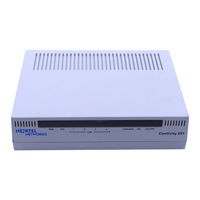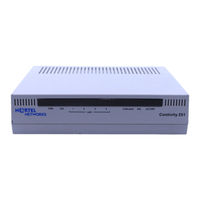Nortel 251 Manuals
Manuals and User Guides for Nortel 251. We have 2 Nortel 251 manuals available for free PDF download: User Manual, Using Manual
Nortel 251 User Manual (485 pages)
VPN Switch
Table of Contents
-
Figures
17 -
Tables
25 -
Preface
31 -
What Is DSL
33 -
-
Multiplexing53
-
VPI and VCI54
-
Nat58
-
DHCP Setup63
-
-
Dynamic DNS73
-
-
WAN Overview86
-
Metric86
-
DTR Signal101
-
Response Strings101
-
-
-
NAT Overview106
-
SUA Server111
-
-
-
-
Rules Overview147
-
Logs151
-
Rule Summary151
-
Timeout159
-
-
-
-
Vpn/Ipsec
174 -
-
Ipsec Algorithms182
-
My IP Address183
-
Keep Alive188
-
NAT Traversal189
-
Pre-Shared Key192
-
Connection Type192
-
IKE Phases206
-
Maintenance
237 -
-
Firmware Screen248
-
-
SMT Introduction255
-
-
-
Dial Backup267
-
-
IP Policies279
-
IP Alias279
-
IP Alias Setup280
-
Route IP Setup282
-
-
-
-
Using NAT307
-
Applying NAT307
-
NAT Setup309
-
-
-
About Filtering329
-
Example Filter343
-
-
-
System Status353
-
Log and Trace357
-
Diagnostic361
-
-
-
-
-
Routing Policy391
-
Appendices
405 -
Appendix Cpppoe
421 -
Appendix J Index
479
Advertisement
Nortel 251 Using Manual (22 pages)
Contivity Configuration Manager to Configure Contivity
Table of Contents
Advertisement

